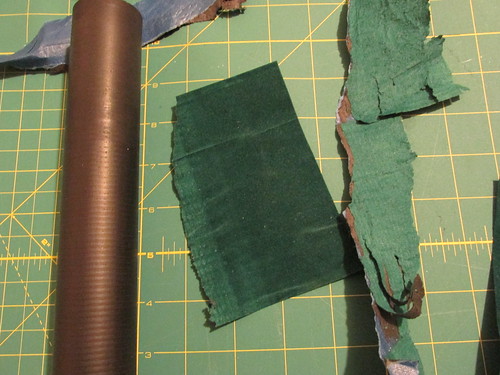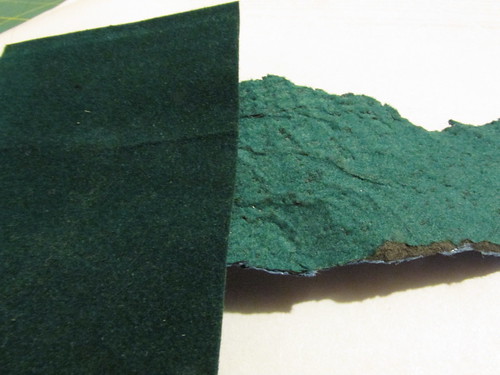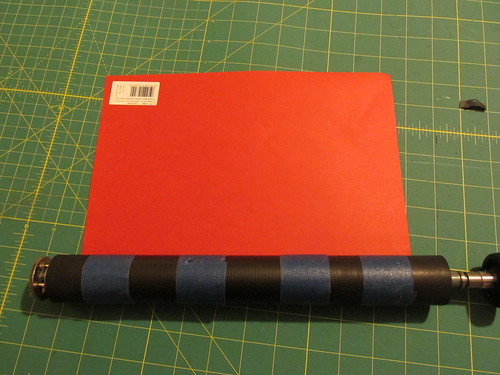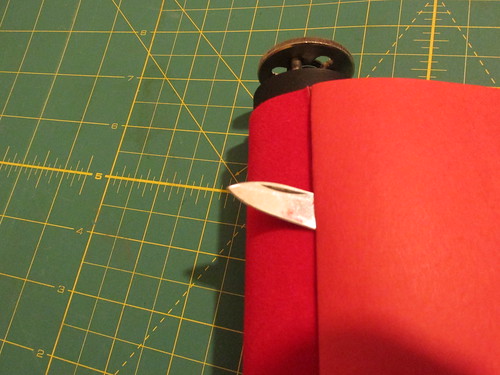The Good:
- It's super-grippy, and seems like a quick and cheap solution to slippery worn platens. I'm running about 6-10 pages per day through the machine, and not a one of them has come through crooked. I've never had this kind of luck with a backing sheet.
- Still an incredible bargain, especially when you coupon-stack and pick numerous replacement sheets from the craft store. Plus, it comes in zebra print which I was not quite bold enough to try (yet.) The color really dresses up the machine, which is in desperate need of it. Royal knew how to make them ugly.
- It is, fundamentally, paper, and as much as I want to pretend it's something more durable or cushioned, it's no replacement for a fresh grippy platen. The one on the Royal is a little rough from many past years in the Typewriter Brigade (this is year #8) and it's now featuring noticeable vertical banding along the rubber from all the impacts. Even with a backing sheet or two, this platen works hard.
- Applying this is still tricky, and getting the seam flat where the ends of the paper meet requires either three hands or a better grasp of geometry. In theory, one should be able to cut right to size. In practice, I just wrapped-and-trimmed. It shows.
- In time, my rough-and-ready tape job showed through. Not by wear in the paper, which held up admirably, but in the wrinkles from the tape surfacing on the paper itself, leading to uneven type. As in many things: take your time and take care.
- Is the fancy paper more cushioned? At least at first it seems like it is. Repeated strikes over a few weeks, though, hammered the surface into oblivion, leaving only the area outside the margins free of problems.
- Has the platen suffered any less damage than it would without paper at all? I don't know. As I subscribe to the backing-sheet-always school of typing, I don't think it's a bad thing. It's made it over 60 years now. Any TLC is probably worthwhile.
I'd hoped to peel the old sheet off somehow and have it laid next to the new one for comparison. This did not happen. Since I'd practically covered the platen in tape, the only way to remove the paper was to tear and peel in a long spiral.
Here you can see the platen on the left -- note the banding from years of typing, some of the paper on the top (the blue-tape side), and fragments that I managed to salvage. Can you tell which part of the green paper was outside the margins?

Here's another comparison of original texture versus the three-weeks-in side. You can see how bad the worn surface was wrinkled at the end. I had wrapped the platen like a barber pole in tape, spiraling down it completely.

The replacement going on. I backed off on the tape this time, going for four loops instead of a complete surface. Nothing is stuck to the rubber of the platen: the tape is fastened only to itself on the ends and slides freely.

The new red wrapper, pre-trimming.

I creased along the edge where the paper meets itself, and then used a sharp pocketknife to slice down the crease to remove the excess. It's still not as good as computing the actual size or the paper needed. There's still a bit of an overlap in the final product, but it's less than my original.

This whole experiment has me looking at other sheets of material at the craft store, too -- nylon sheets, maybe actual felt instead of faux-felt... upholstery fabric? The possibilities are endless. I don't know if it has much real merit beyond short-term writing projects like Nanowrimo, or maybe the occasional photo shoot, but I'm still happy with the results.
Now, if someone just sold a wrapper that made my plot better...

2 comments:
Very crafty. I'd thought about doing something like this for when I use a BAROP or LAROP, since it's difficult to use a backing sheet with a continuous roll of paper. Hopefully you'll do another article when you find the optimal type of material. And wouldn't it be neat if you could figure out how to do this without removing the platen! Just roll something in, pull off a strip of paper to reveal some adhesive and glue down. Presto! I see a potential product there for the small typewriter community: platen condoms. Or maybe I need another cup of coffee.
wouldn't a "platen condom" be heat-shrink tubing? :D
so you're using felt paper? for some reason I thought you used the sticky-back craft felt I often use for replacing the sound baffling in machines.
Post a Comment